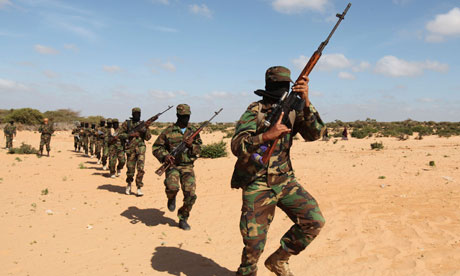 |
| a Shabaab militants train in Somalia in conflict against Kenyan forces Feisal Omar/Reuters |
The attack in on the Westgate shopping mall represents a change in direction and strategy for the al Shabaab group.
Analysis
At approximately around noon on Sept. 21st, armed Somali gunmen executed a complex attack on the Westgate shopping mall in Nairobi, Kenya. The attack left more than 70 civilians dead with similarities and connotations with the 2008 Mumbai terror attacks and will likely a response by Kenya's security forces to search and destroy strongholds in Somalia belonging to al Shabaab. The attack puts into perspective the vision of al Shabaab's position and strategy in Somalia.
It is important to understand the formation of al Shabaab. Somalia is a predominately Sunni nation which consequently attracted and the source of al-Qaeda fighters throughout the years. The dysfunctional security services in Somalia in the 90s permitted the training, recruitment and planning of various low-intensity operations in Eastern Africa. These fighters could then be exported to other regions of the world, most notably, Pakistan, Afghanistan, Iraq et al. Since Ethiopian forces dismantled the Supreme Islamic Courts Council (SICC) in Somalia in 2007, the SICC and its fighters splintered into various different groups, one of those being al Shabaab.
It has been often noted that al Shabaab have been aspiring to transnational capability, akin to an al-Qaeda franchise. This is expected, given the group's core membership consists of predominately of senior militants of al-Qaeda, veterans of the wars in Afghanistan. Naturally, the strategic direction of the group was to have a strong presence in Somalia to facilitate attacks transnationally while resisting the surges of neighbouring nation's attempts to dismantle the organization.
al Shabaab have approximately 6500 militants in its ranks. The bulk of the organization have experience in asymmetrical warfare and are operationally effective at prolonged insurgency. They are more than familiar with the use of small arms, hit-and-run tactics and emphasis on small-unit organization.
Having lost the majority of its territory in Somalia in 2010-12, the group is becoming weaker and therefore a greater emphasis on insurgency is required. The group will, despite previous attempts, not conventionally defeat the Kenyan security forces in Somalia. Instead, the group will aim to draw thee Kenyan's into greater commitments in Somalia, draining Kenya in a prolonged counterinsurgency campaign. Something which will be required to combat the group.
al Shabaab's training and expertise in asymmetric warfare is a concern for Kenya but they face challenges. Firstly, one of the major concerns is funding. Having lost the port of Kismayo in September 2012, it has become troublesome for the group to acquire funding to sustain its military presence. Secondly, its network in Kenya is diminishing.
The attack on the Westgate shopping centre is more of a dramatic propaganda bid to consolidate the losses al Shabaab have suffered in the past two years. Despite the profile of the attack, for al Shabaab militants this was relatively easy to execute. Armed assault operations are comparatively easier than high-profile explosives in densely populated areas. As mentioned before, the tradecraft that is abundant in al Shabaab's ranks mean that the Westgate attack is of minimal resource for the group.
The Westgate attack will more likely result in an overt retaliation to combat al Shabaab militants. Given the expertise in insurgency that al Shabaab possess, it is unlikely of further breakthroughs to dismantle the organization. For Kenya, it is likely that in response to such attacks, the Eastleigh district will more than likely become victim of rioting as noted in previous attacks by al Shabaab and sympathizers. Despite the commotion and profile of the attack, this represents a thorn and subtle desperation in al Shabaab leadership.

No comments:
Post a Comment